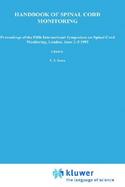Handbook of Spinal Cord Monitoring Proceedings of the Fifth International Symposium on Spinal Cord Monitoring, London, Uk, June 2-5, 1992
- List Price: $289.00
- Binding: Hardcover
- Publisher: Kluwer Academic Print on Demand
- Publish date: 02/01/1994
Description:
Invited Chapters.- 1 Somatosensory evoked potentials and their use for spinal cord monitoring.- 2 Human spinal cord potentials recorded from the epidural space.- 3 Indications for the use of evoked potentials in spinal surgery -- review of the Nottingham experience and current use.- 4 Anaesthetic requirements for spinal surgery and effective cord monitoring.- 5 Application of intraoperative spinal cord monitoring to neurosurgery.- 6 Lessons from spinal cord monitoring.- 7 A multicentre survey of spinal cord monitoring outcome.- 8 Round Table Debate on International Spinal Cord Monitoring Practice.- Present status of spinal cord monitoring in Japan.- Spinal cord monitoring in the UK.- General perception of the usefulness and failings of spinal cord monitoring. The U.C.L. experience.- Somatosensory and spinal cord evoked potential studies in humans.- 9 Spinal cord evoked potentials in cervical and thoracic myelopathy.- 10 Spinal cord evoked potentials in spinal cord intermittent claudication.- 11 Somatosensory cerebral potentials evoked by paraspinal stimulation: an approach to spinal cord monitoring.- 12 The effect of changes in epidural temperature on spinal evoked potentials during scoliosis surgery.- 13 Threatened spinal cord damage due to Luque''s wires.- 14 Comparison of common peroneal and posterior tibial nerve stimulation for routine spinal cord monitoring during surgical correction of scoliosis.- 15 An explanation of the high ''false-positive'' rate of lower limb SEPs in descending aorta surgery.- 16 Decomposition of spinal cord evoked potentials into propagating and stationary components.- 17 An atlas of human spinal cord evoked potentials.- 18 A multichannel planar epidural electrode for spinal cord monitoring.- 19 Somatosensory evoked potentials (EPs) during anterior and posterior spinal surgery.- 20 Spinal cord monitoring with a new device for automated signal analysis.- 21 Evaluation of peroperative sensory evoked potentials recorded from nerve roots to the cervical epidural space during brachial plexus surgery.- 22 Automated spinal cord monitoring system with multimodal evoked potentials.- 23 Pain-related somatosensory evoked potentials following CO2 laser stimulation in myelopathy.- 24 Level diagnosis of cervical myelopathy using somatosensory evoked potentials.- 25 Spinal cord monitoring during surgery for intramedullary spinal cord tumours.- 26 Graded risk levels of somatosensory evoked potentials during scoliosis surgery.- 27 Intraoperative spinal cord monitoring with spino-spinal evoked potentials.- 28 Monitoring cortical evoked potentials (EPs) in operations on the cervical spine.- 29 A computer simulation of conduction block -- conduction block induced augmentation and killed-end potential.- 30 Quantifying the SSEP -- the area under the curve.- 31 The effects of propofol and nitrous oxide on median nerve somatosensory evoked potentials during fentanyl anaesthesia.- Studies of the human motor system.- 32 Effects of anaesthesia on the EEG -- bispectral analysis correlates with movement.- 33 H-reflex spinal cord monitoring during vertebral column stabilization surgery.- 34 Central motor conduction time to upper versus lower extremities.- 35 Do neurogenic lesions of the spinal cord generate distinctive features of the epidurally recorded motor evoked potential'.- 36 Anaesthesia and the motor evoked potential.- 37 A method to assess the effect of neuromuscular blocking agents on the spinal motor evoked potential during spinal surgery.- 38 Defining reliable anaesthetic protocols for intraoperative monitoring of transcranial magnetic motor evoked potentials.- 39 Transcranial magnetic stimulation for spinal cord monitoring.- 40 Evaluation of motor pathways in patients with cervical myelopathy by magnetic stimulation: pre-, intra-, and postoperative study.- 41 An attempt at noninvasive mapping of the human motor cortex using transcranial magnetic stimulation.- 42 Separation of upper and lower extremity components of the cortico spinal MEP (D-wave) recorded at the cervical level.- 43 Changes in the corticospinal MEP (D-wave) during microsurgical removal of intramedullary spinal cord tumours; experience in 16 cases.- 44 Ketamine anaesthesia allows recording of muscle responses to magnetic cortical stimulation: an electrophysiological study in man.- 45 Long-term and quantitative assessment of spinal cord motor function by motor evoked potentials..- 46 Correlation of clinical, radiological and electrophysiological (MEP) findings in cervical myelopathy.- 47 Recording of myogenic motor evoked potentials (mMEP) under general anaesthesia using a train of transcranial electric stimuli.- 48 Electromyography of paravertebral muscles for evaluation of spinal disorders.- 49 Differential effect of isoflurane on motor evoked potentials elicited by transcortical electric or magnetic stimulation.- 50 Temporal summation and motor evoked potential spinal cord monitoring in man.- 51 Near maximal transcranial magnetic motor evoked potentials during surgery.- 52 Rapid changes in killed-end corticospinal MEP in patients with acute spinal cord injury.- Animal studies.- 53 Electrophysiological phenomena recorded from spinal cord slice preparation in the adult rat.- 54 Transcranial magnetic motor evoked potentials recorded from the spinal cord in cats: normal waves and spinal cord injuries.- 55 In vitro animal study of the spinal cord evoked potentials.- 56 Comparison of spinal evoked potentials by transcranial magnetic and electrical stimulation -- a canine study.- 57 Comparison between descending segmental evoked spinal cord potentials and conductive evoked spinal cord potentials under acute spinal cord compression.- 58 Refractory period of motor evoked potentials and spinal cord evoked potentials in the cat.- 59 The effect of anaesthetic agents on descending spinal cord evoked potential and the compound muscle action potentials elicited by stimulation at the motor cortex and the spinal cord.- 60 Acute motor evoked potential changes following spinal cord ischaemia in the rat.- Index of Authors by Chapter Number.
Expand description

Please Wait

